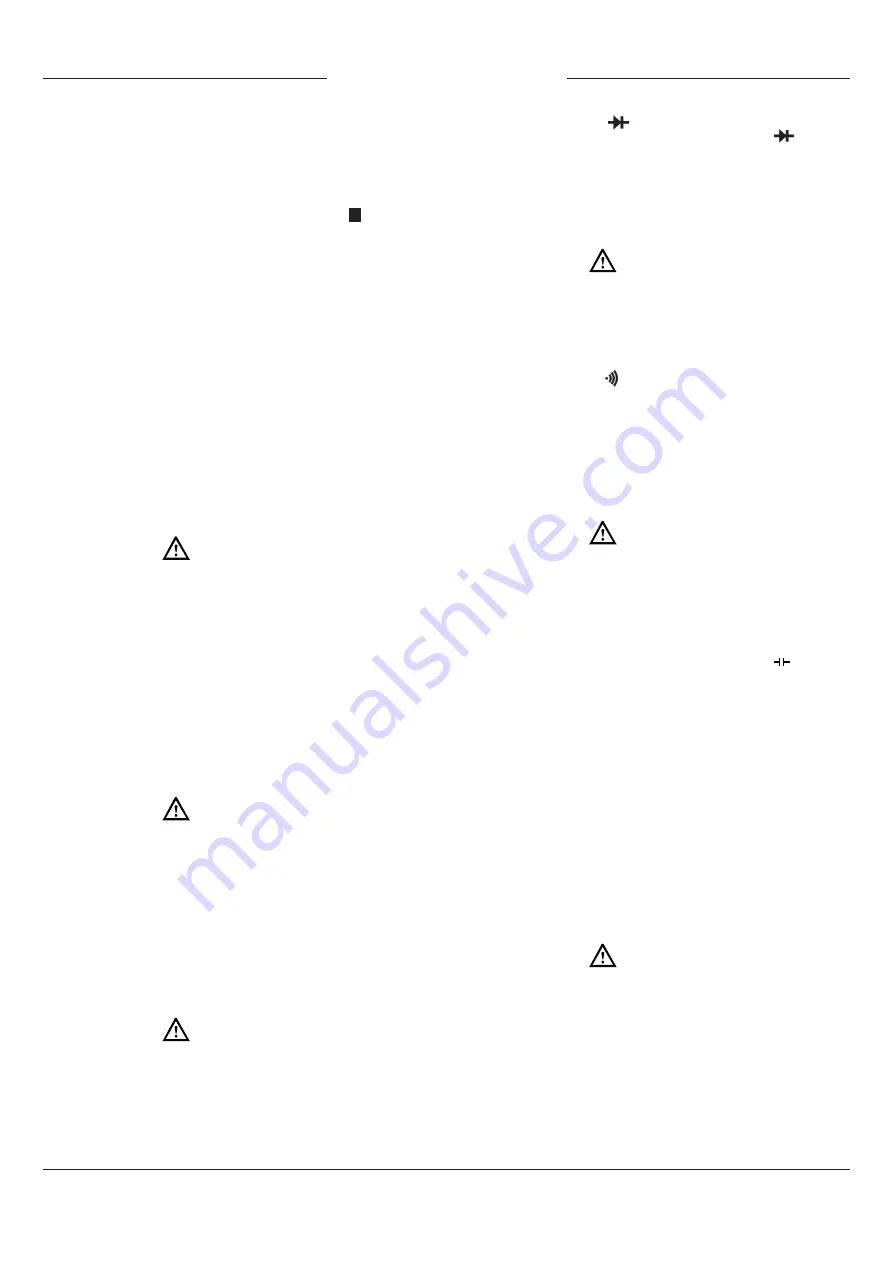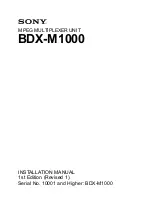
ELCART
ELCART DISTRIBUTION SPA via Michelangelo Buonarroti, 46 - 20093 Cologno Monzese (Milano) ITALY
Tel. +39 02.25117310 Fax +39 02.25117610 sito internet: www.elcart.com e-mail: [email protected]
Manuale di istruzioni/Scheda tecnica
La divulgazione dei dati contenuti in questa scheda è da ritenersi un servizio puramente informativo e non costituisce alcun vincolo da parte della Elcart in merito a prestazioni ed utilizzo del prodotto.
The divulgation of data contained on this technical sheet are exclusively for informational reasons and establish no link on behalf of Elcart regard to thr performances and the usa of the product.
La divulgacion de los datos contenidos en esta ficha son un servicio unicamente informativo y no constituyen ningun vinculo de parte de Elcart respecto a las prestaciones y uso del producto.
ART. 9/9450
PAGINA 7 DI 9
3. FUNCTION DESCRIPTION
3.1 General Functions
3.1.1 DATA HOLD mode
Data Hold mode makes the meter stop updating the display.
Data Hold function can be cancelled by changing the measurement
mode, or push HOLD key again.
To enter and exit the Data Hold mode:
1. Press HOLD key, fixes the display on the current value, is displayed
2. A second short press returns the meter to normal mode.
3.1.2 Battery Saver
The meter will be turned OFF automatic after approx 15 minutes
3.1.3 Non Contact AC Voltage detection
Hold the Meter so that the Meter’s top is vertically and horizontally cen-
tered and contacting the conductor, when the live voltage >110V(RMS),
the sensing indicator will be on.
Note:
1. Even without LED indication, the voltage may still exist.
Do not rely on non-contact voltage detector to determine the presence
of voltage wire; detection operation may be subject to socket design,
insulation thickness and different type and other factors.
2. When the meter input terminals presence voltage, due to the influence
of presenced voltage, voltage sensing indicator may also be bright.
3. Keep the meter away from electrical noise sources during the tests,
i.e., fluorescent lights, dimmable lights, motors, etc..
These sources can trigger NON-Contact AC Voltage Detection Function
and invalidate the test.
3.2 Measurement Functions
3.2.1 AC and DC Voltage measurement
WARNING
To avoid electrical shock and/or damage to the instrument,
do not attempt to take any voltage measurement
that might exceeds 1000Vdc or 750Vac rms.
The polarity of AC (alternating current) voltage varies over time;
the polarity of DC (direct current) voltage is constant.
DC voltage ranges are:
200mV, 2V, 20V, 200V, 1000V
AC voltage ranges are:
2V, 20V, 200V, 7500V
To measure AC or DC voltage:
1. Set rotary switch to the proper range.
2. Connect the black test lead to the COM and red to the V terminals
3. Connect the test leads to the circuit being measured
4. Read the displayed value.
The polarity of red test lead connection will be indicated when making a
DCV measurement.
3.2.2 Resistance measurement
WARNING
To avoid electrical shock and/or damage to the instrument,
disconnect circuit power and discharge
all high-voltage capacitors before measuring resistance.
Resistance ranges are: 200Ω, 2kΩ, 20kΩ, 200kΩ, 2MΩ, 20MΩ, 200MΩ
To measure resistance:
1. Set the rotary switch to proper range.
2. Connect the black test lead to the COM and red to the V terminals
3. Connect the test leads to the circuit being measured and read the
displayed value.
NOTE
:
On 20MΩ and 200MΩ ranges, the meter may take a few seconds to
stabilize reading; this is normal for high resistance measuring.
3.2.3 Diode Test
WARNING
To avoid electrical shock and/or damage to the instrument,
disconnect circuit power and discharge
all high-voltage capacitors before testing diodes.
Use the diode test to check diodes, and other semi-conductor devices.
The diode test sends a current through the semiconductor junction, and
then measures the voltage drop across the junction; a good silicon junction
drops between 0.5V and 0.8V.
To test a diode out of a circuit:
1. Set the rotary switch to range.
2. Connect the black test lead to the COM and red to the terminals
3. For forward-bias readings on any semiconductor component, place
the red test lead on the component's anode and place the black test
lead on the component's cathode.
4. The meter will show the approx. forward voltage of the diode.
If the test lead connection is reversed, only figure "1" displayed.
3.2.4 Continuity Check
WARNING
To avoid electrical shock and/or damage to the instrument,
disconnect circuit power and discharge
all high-voltage capacitors before testing for continuity.
Continuity is a complete path for current flow, the beeper sounds if a circuit
is complete. These brief contacts cause the meter to emit a short beep.
To test for continuity:
1. Set the rotary switch to range.
2. Press the yellow key twice to activate Continuity Check.
3. Connect the black test lead to the COM and red to the Ω terminals
4. Connect the test leads to the resistance in the circuit being measured
5. When the test lead to the circuit is below approx. 30Ω, a continuous
beeping will indicate it.
Note:
- Continuity test is available to check open/short of the circuit.
3.2.5 Capacitance measurement
WARNING
To avoid electrical shock and/or damage to the instrument,
disconnect circuit power and discharge all high-voltage capacitors
before measuring capacitance. Use the DC voltage function
to confirm that the capacitor is discharged.
Capacitance ranges are:
20nF, 200nF, 2µF, 200µF
To measure capacitance:
1. Set the rotary switch to proper range.
2. Connect the black test lead to the COM and red to the terminals
3. Connect the test leads to the capacitor being measured
4. Read the displayed value
Note:
* The meter may take a few seconds to stabilize reading.
This is normal for high capacitance measuring.
* To improve the accuracy of measurements less than 20nF, subtract
the residual capacitance of the Meter and leads
3.2.6 Inductance measurement
The unit of inductance is the Henry (H)
Inductance ranges are:
20mH, 200mH, 2H, 200H
To measure inductance:
1. Set the rotary switch to proper range.
2. Connect the black test lead to the COM and red to the LX terminals
3. Connect the test leads to the inductance being measured
4. Read the displayed value
3.2.7 Transistor measurement
WARNING
To avoid electrical shock and/or damage to the instrument,
do not apply more than 250Vdc or 250Vac rms between the hFE
terminal and the COM terminal.
1. Set the rotary switch to hFE range.
2. Connect the “com” plug and “+” plug of the special multi-function
socket to the COM and hFE terminals.
3. Determine whether the transistor to be tested is NPN or PNP type
and locate the Emitter, Base and Collector leads.
4. Insert leads of the transistor into proper holes of the special
multi-function socket.
5. The meter will show the approx. hFE value at test condition of base
current 10μA and Vce 2.8V.
H



























